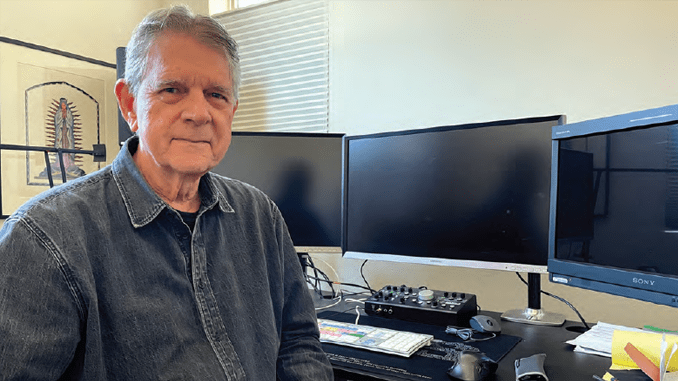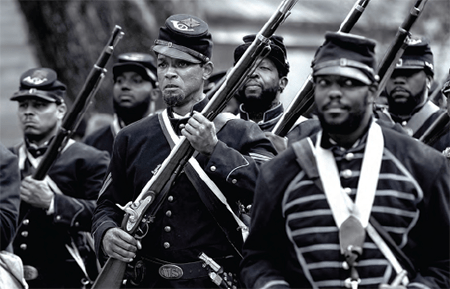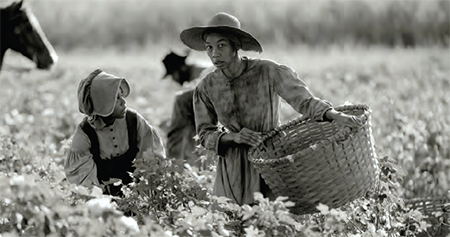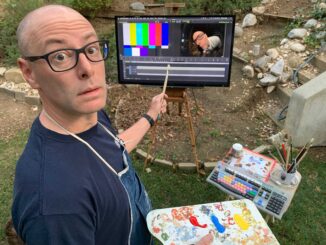
By Peter Tonguette
Conrad Buff, ACE, is many things: an Oscar winner for James Cameron’s “Titanic” (1997), a master of action on the strength of his work on Cameron’s “Terminator 2: Judgment Day” (1991) and McG’s “Terminator Salvation” (2009), and even an expert in comedy, as seen in Mel Brooks’s “Spaceballs” (1987) and Kinka Usher’s “Mystery Men” (1999).
Buff, it turns out, is also something of a history buff.
The acclaimed picture editor tapped his interest in history for his latest film, Antoine Fuqua’s true-life Civil War-era drama “Emancipation.” The Apple Original Films release, which debuted on Apple TV+ in December, stars Will Smith as Peter, an enslaved Black man who escaped from a Confederate war camp, successfully made his way through the untamed backcountry of Louisiana while eluding those sent to find him — including overseer Jim Fassel (Ben Foster) — and later spent time as a Union soldier in the war. In images that appeared in Harper’s Weekly, Peter was photographed from an angle that exposed his back, which had been disfigured due to horrific lashings; the photography session is reproduced in the film.
Besides working again with Fuqua — a regular collaborator with whom Buff has worked extensively since first making the acclaimed “Training Day” (2001), including “Tears of the Sun” (2003) and “Shooter” (2007) — “Emancipation” offered Buff a chance to explore a brutal passage in American history.

“History is seductive for me,” Buff told CineMontage in a recent phone interview. “When Antoine informed me that he and Will were working on a script, and told me what the subject matter was, I thought, ‘Oh my goodness. I’d love to be involved with that.’ . . . The period for me is just very, very interesting, so that was a big seduction.”
What follows are excerpts from CineMontage’s conversation with Buff.
CineMontage: Can you talk about your collaboration with Antoine Fuqua?
Conrad Buff: “Training Day” was, I believe, his second feature. He was greener, but he certainly had a strong hand and a lovely demeanor. That was a strange film to put together. It was so shot out of sequence that I never had scenes that I could necessarily connect and get any kind of run at. . . . Finally, when I had enough material, I remember running out of this bathroom-sized editing room I had at Warner Bros. saying to my crew, “My God, this is a really good movie.” I had no idea, putting it together, how it would come out. But honestly, it’s one of my favorite films on my resume.
CineMontage: After making “Shooter” with Fuqua in 2007, you didn’t resume your collaboration until “The Equalizer 2” in 2018. Was he the same director when you got back together?
Buff: Clearly, he was more experienced, more sophisticated. There was a confidence there to begin with, but not an ego that was difficult to work with by any means. [He says], “Here’s the material. Have your way with it, and then we’ll talk about it.” Today, we have PIX, which is a great communicator. For instance, on “Emancipation,” it was the first time I was not on location on a film. There wasn’t much point. They were in the swamps of Louisiana. We communicated by text a great deal — later on, I had Evercast available — and I could post sequences to him on PIX and we could talk about it. Because there’s a certain amount of comfort that we have, we can speak our minds.
CineMontage: Was there any particular reason you didn’t go on location on “Emancipation”?
Buff: They weren’t able to accomplish a lot within a day — exacerbated by COVID, hurricanes, the physical conditions. It was very challenging physically for production. I was in the comfort of my home. In spite of the very difficult subject matter, for me it was very easy to work on, and honestly quite a pleasure and an honor for me to get to do it. Once we got into director-cut mode, again it was the COVID world. Antoine and I worked with Evercast. He was at home, I was at home. . . . A great deal of what I did pretty much remained unchanged. In fact, the battle at the end, I sent it to Antoine. First of all, I was unbelievably blown away by the material that they shot in all of ten days for that end battle. How they choreographed that was reminiscent to me very much of [D.W. Griffith’s] “Birth of a Nation,” and absolutely beautiful. Structurally, I put that together pretty easily. That was the least challenging area of the film. When I sent it to Antoine, he said, “Don’t change a frame.” And then, he sent back, “Well, there’s one little area where Peter shoots one of the Confederate soldiers that I’d like you to adjust.” Other than that, it’s intact.

CineMontage: The film was photographed by Robert Richardson, ASC, who created a look that primarily reads as black-and-white but has occasional sparks of color.
Buff: I was receiving dailies that pretty much looked like what the final film looked like. Rob Legato, our visual effects supervisor and second-unit director, and Bob collaborated on how to define the look. It’s unique, I’ve never seen it before. They could shoot in color but basically desaturate it, and then bring out, to whatever degree they wanted, color in isolated areas.
CineMontage: How did you approach the long passage of Peter on the run following his escape? It relies on the physicality of Will’s performance, because there’s not very much dialogue, and it’s largely from his point-of-view.
Buff: That was the most difficult area for me, frankly. There was a good amount of material in various environments. There was a certain progression script-wise that was designed, but again, very subjective amount of material, more documentary-like. . . . My first cut of that second act basically was just so fat and, honestly, at times, tedious. I had to figure out how to parallel the stories up of Fassel, the family, and Peter. How do I add tension? How do I let it breathe because there’s so much room for enjoying the environment and just the action? That took the most time — to finally arrive at a balance that worked.
‘It helps just to kill the sound and see everything visually.’
It was impossible to record any kind of sound for a lot of it, given what the situation was, so a lot of it’s MOS [i.e., was shot with no synchronous audio track]. I have to credit [supervising sound editor and re-recording mixer] Dave Esparza, [supervising sound editor] Mandell Winter, and [re-recording mixer] Steve Pederson for elevating it way beyond what I constructed. Sonically, it’s just a beautiful, beautiful job of Foley and backgrounds and details, sound effects. . . . [Before their work], we’re looking at people running through swamps with no footsteps, no water, no mosquitoes. To make that come alive was great fun to work on, in spite of the dark material.
CineMontage: Since so much of this sequence is without dialogue, was it like cutting a silent movie?
Buff: Well, a lot of times, even in a dialogue situation, I will turn the sound off and just watch the pattern. Do I like the visual and editorial structure? It really helps sometimes just to kill the sound — I know what the dialogue is — and just see the arrangement visually, cinematically, not being driven by anything sonically. [“Emancipation”] is certainly one of the first times in years that I’ve had that much MOS material.
CineMontage: What do you hope audiences take from “Emancipation”?
Buff: The realities of what did go on — maybe not literally, because this is a dramatized film — but those types of experiences that people endured, and that kind of hatred and treatment, that still goes on. We’re still trying to overcome a lot of that, not only in the U.S. but internationally.
CineMontage: Was it draining to edit the film?
Buff: Yes, for sure. I’m divorcing myself to a degree, being an objective filmmaker/editor. I think it was much more difficult for the production crew. I know production was very sensitive to the fact that the subject matter was a challenge. In the call sheets there were notes that if anyone would like support or help on a daily basis — this was offered during the making of the film. Because I’m somewhat detached from the physical production in this case, it might’ve been a lot easier for me to deal with. It’s tough stuff.






